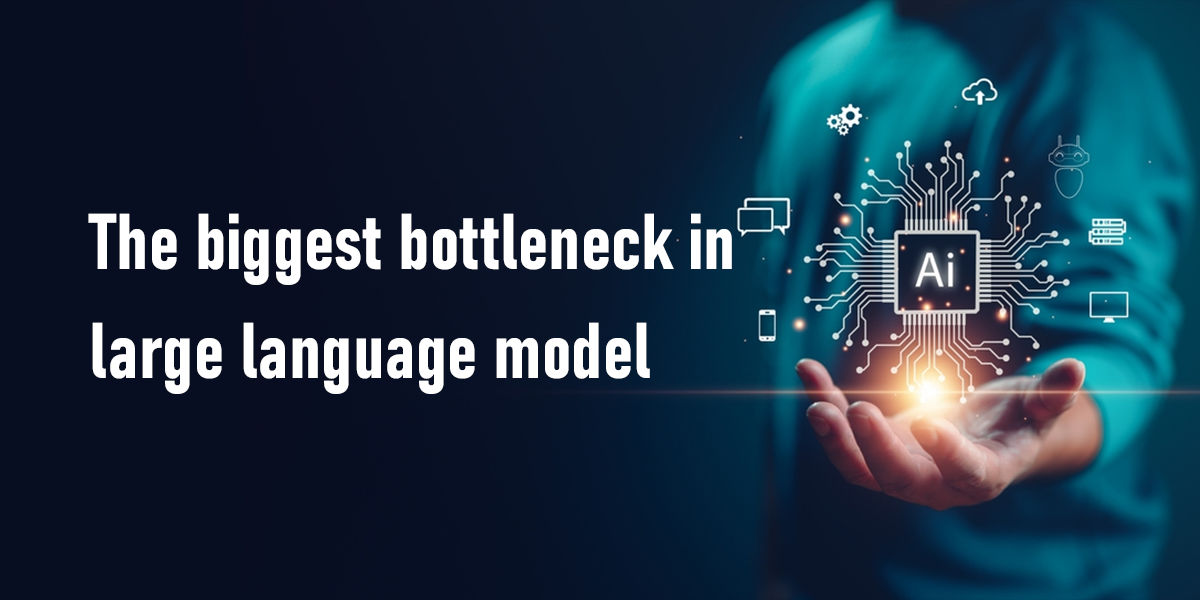The biggest bottleneck in large language model

Data Analyst
Experienced data analyst working with data visualization, cloud computing and ETL solutions.
February 03, 2024

In the realm of artificial intelligence, large language models have emerged as powerful tools, revolutionizing natural language processing tasks. From OpenAI's GPT-3 to BERT, these models exhibit remarkable language understanding capabilities. However, behind their facade of linguistic prowess lies a significant bottleneck — a challenge that transcends the realms of computational power, environmental impact, and data privacy. In this deep dive, we unravel the complexities surrounding the biggest bottleneck in large language models, exploring the hurdles that hinder their seamless integration into our technological landscape.
1. Computational Power and Training Time :
At the heart of the bottleneck lies the insatiable hunger for computational power during the training phase. Large language models, like GPT-3, demand vast amounts of computing resources, including high-performance GPUs or TPUs and distributed computing infrastructure. The training process, an intricate dance of optimization algorithms on massive datasets, extends over weeks or months. The sheer scale of computation required not only limits accessibility but also inflates the operational costs for organizations committed to harnessing the power of these models.
The quest for more robust language understanding and context necessitates larger model sizes, exacerbating the computational demands. Researchers constantly walk the tightrope between model complexity and training feasibility, exploring ways to strike a balance that ensures optimal performance without imposing astronomical resource requirements.
2. Inference Latency :
While training poses its challenges, the story doesn't end there. The deployment and usage of large language models face a separate hurdle during the inference phase — latency. The gargantuan size of these models translates into substantial memory and processing requirements, leading to slower response times. This latency becomes a critical concern in real-time applications, such as interactive chatbots or services requiring swift user interactions.
The struggle to achieve low-latency inferencing without sacrificing model accuracy remains an ongoing battle. Techniques like model quantization, where the precision of the model's weights is reduced, are explored to mitigate this bottleneck. However, finding the sweet spot between latency and model fidelity proves to be a delicate balancing act.
3. Memory Requirements :
Large language models are voracious consumers of memory, both during training and inference. The expansive vocabulary and intricate contextual dependencies demand substantial memory capacity, which can be a limiting factor for deployment in resource-constrained environments. Edge computing devices or systems with limited memory face challenges in accommodating these memory-hungry models.
As researchers strive to make these models more accessible and applicable in diverse settings, innovations in model architectures and memory-efficient strategies become imperative. Model pruning, which involves removing less critical weights, and knowledge distillation, where a smaller model learns from the larger one, are avenues explored to reduce memory requirements.
4. Environmental Impact :
The colossal computational requirements for training large language models raise concerns beyond the confines of data centers and research labs — they extend to the environment. The environmental impact of running these resource-intensive models has become a focal point in discussions surrounding the sustainability of artificial intelligence.
The carbon footprint associated with the energy consumption of data centers that power the training processes is substantial. The ecological ramifications are prompting researchers and organizations to explore greener alternatives. Initiatives such as using renewable energy sources, optimizing data center efficiency, and developing more energy-efficient hardware are underway to address the environmental concerns associated with large-scale AI models.
5. Data Privacy and Security :
As these language models evolve, another critical bottleneck comes to light — the intricate dance between innovation and data privacy. The training of large language models relies on vast and diverse datasets, often raising questions about the privacy and security of the information contained within.
The ethical use of data and the potential for unintended biases present challenges that researchers and developers must grapple with. Striking a balance between pushing the boundaries of language model capabilities and respecting user privacy is a delicate endeavor. Differential privacy techniques, which add a layer of noise to the training data, are explored to protect individual data points, but ensuring the ethical and secure use of data in the development and deployment of these models remains an ongoing concern.
6. AI-Powered Code Suggestions and Autocomplete :
Amidst the computational intricacies, another bottleneck emerges in the realm of AI-powered code suggestions and autocomplete features. Integrating machine learning algorithms into the development environment has proven to be both a boon and a challenge. The sophisticated models that power code suggestions require substantial computational resources, impacting the responsiveness of Integrated Development Environments (IDEs) during real-time coding.
The challenge extends beyond resource demands. As developers increasingly rely on these AI-driven features, the need for model accuracy and relevance becomes paramount. Striking a balance between providing helpful suggestions and avoiding overwhelming developers with irrelevant or distracting information is a constant tightrope walk. Continuous advancements in model architectures and training strategies aim to refine these AI-powered tools, enhancing their utility without compromising the developer experience.
7. Real-Time Collaboration and Pair Programming (Approx. 200 words):
Collaborative development, facilitated by real-time collaboration tools and pair programming features, introduces a unique set of challenges. The demand for seamless real-time code sharing and collaborative editing poses additional stress on computational resources. Ensuring a synchronized and lag-free experience for developers working in tandem requires robust infrastructure and optimized communication protocols.
Beyond the technical challenges lie considerations of security and privacy. As developers collaborate in real-time, the need to protect sensitive code and data from unauthorized access becomes paramount. Implementing secure and privacy-preserving mechanisms within these collaborative environments adds an additional layer of complexity to overcome in the quest for efficient and secure pair programming experiences.
8. Improved Accessibility Tooling :
While advancements in accessibility tooling are crucial for creating inclusive applications, integrating these features into the development workflow presents its own set of challenges. Accessibility testing tools, designed to identify and address potential issues, demand computational resources for thorough analysis. Ensuring that these tools seamlessly integrate into the development pipeline without causing significant workflow disruptions is a balancing act that developers and tool providers must navigate.
Moreover, the ever-evolving landscape of web technologies and frameworks introduces compatibility challenges for accessibility tools. Staying abreast of the latest standards and technologies while providing consistent and accurate accessibility feedback requires continuous updates and refinements. This iterative process aims to bridge the gap between the development of accessible applications and the tools that facilitate their creation.
9. Extended Browser Compatibility :
The demand for extended browser compatibility adds another layer to the computational tapestry. Large language models must account for the nuances of different browsers and their evolving standards. Ensuring that applications built with these models run seamlessly on the latest versions of Chrome, Firefox, Safari, Edge, and other browsers requires ongoing testing and optimization.
Browser compatibility challenges also intersect with the need for performance optimization. Balancing the intricacies of browser-specific rendering engines and ensuring efficient execution of code across diverse environments adds complexity to the development process. Adopting a holistic approach that considers both model optimization and browser-specific nuances becomes imperative to provide a consistent and reliable user experience across the vast landscape of web browsers.
10. Seamless Integration with Cloud Services :
While the integration of large language models with cloud services unlocks new possibilities, it introduces its own set of challenges. Cloud services offer scalability and flexibility, enabling developers to leverage powerful resources on-demand. However, optimizing the integration to ensure a seamless and efficient flow of data between the model and cloud services demands careful consideration.
The challenges extend beyond technical integration to encompass issues of data transfer, storage, and security. Efficiently managing the flow of data between the local environment and the cloud, especially when dealing with large datasets or real-time interactions, requires robust infrastructure and thoughtful architecture. Striking a balance between leveraging the benefits of cloud services and mitigating potential bottlenecks in data transfer and processing is critical for achieving optimal performance.
Conclusion:
As we delve deeper into the intricacies of large language models, the computational tapestry unravels to reveal a complex landscape. The bottlenecks in AI-powered code suggestions, real-time collaboration tools, accessibility tooling, browser compatibility, and cloud service integration underscore the multifaceted nature of challenges faced by developers. Striking a delicate balance between innovation, resource efficiency, and user-centric design is the ongoing pursuit that defines the future of AI in software development. As researchers, developers, and organizations collaborate to overcome these challenges, the evolution of large language models continues, promising a future where AI seamlessly integrates into our development workflows while upholding the principles of efficiency, accessibility, and responsible use.













